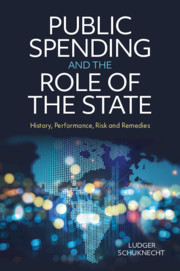Book contents
- Public Spending and the Role of the State
- Public Spending and the Role of the State
- Copyright page
- Dedication
- Contents
- Figures
- Tables
- Preface
- Acknowledgements
- Acronyms and Abbreviations
- Introduction
- Part I The Growth of Government
- 1 The Growth of Government Expenditure over the Past 150 Years
- 2 The Composition of Expenditure
- 3 Financing Government
- Part II Value for Money
- Part III Fiscal Risks
- Part IV Remedies
- Table of Data Sources
- Bibliography
- Index
1 - The Growth of Government Expenditure over the Past 150 Years
from Part I - The Growth of Government
Published online by Cambridge University Press: 30 October 2020
- Public Spending and the Role of the State
- Public Spending and the Role of the State
- Copyright page
- Dedication
- Contents
- Figures
- Tables
- Preface
- Acknowledgements
- Acronyms and Abbreviations
- Introduction
- Part I The Growth of Government
- 1 The Growth of Government Expenditure over the Past 150 Years
- 2 The Composition of Expenditure
- 3 Financing Government
- Part II Value for Money
- Part III Fiscal Risks
- Part IV Remedies
- Table of Data Sources
- Bibliography
- Index
Summary
The role of government has evolved significantly over the past 150 years. In the late nineteenth century, only about 10% of GDP passed through the hands of government. This was consistent with the prevailing view that government should only be minimally involved in the economy. By 1960, public spending had increased to 25–30% of GDP as governments focussed on delivering their core tasks: rules of the game, public goods and services and basic safety nets. Private choice still predominated and safeguarded both economic and financial freedom. The Keynesian ‘revolution’ from 1960 to about 1980 saw government grow to 50% and 60% of GDP in some countries and to over 40% on average. Over the next two decades, the classical ‘counter-revolution’ propagated smaller states. Many countries began fiscal reform and rules-based policy-making gained prominence. Spending growth came to a halt, and in some cases reversed. The years since 2000 have seen a revival of Keynesian thinking. Countries engaged in expansionary policies before the global financial crisis and experienced new record highs in public expenditure and debt thereafter. Another wave of reforms brought spending down in some crisis countries in the 2010s. However, public spending ratios on average rose well above the level of 2000.
Keywords
- Type
- Chapter
- Information
- Public Spending and the Role of the StateHistory, Performance, Risk and Remedies, pp. 17 - 35Publisher: Cambridge University PressPrint publication year: 2020
- 1
- Cited by

